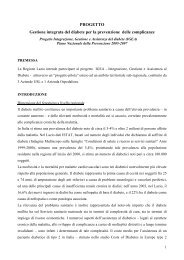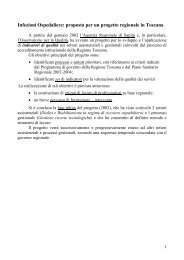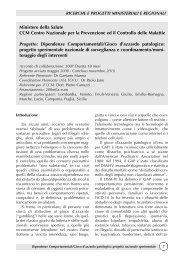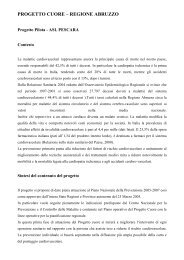Gaining health : analysis of policy development in European ...
Gaining health : analysis of policy development in European ...
Gaining health : analysis of policy development in European ...
Create successful ePaper yourself
Turn your PDF publications into a flip-book with our unique Google optimized e-Paper software.
Chapter 2<br />
History and context <strong>of</strong> policies<br />
to tackle NCD<br />
Péter Makara & Jill L. Farr<strong>in</strong>gton<br />
The historical orig<strong>in</strong>s and the period <strong>of</strong><br />
pilot projects<br />
Before analys<strong>in</strong>g policies for tackl<strong>in</strong>g NCD that exist <strong>in</strong><br />
Europe today, we would do well to look to the past for<br />
guidance and a better understand<strong>in</strong>g <strong>of</strong> their orig<strong>in</strong>s. The<br />
historical <strong>development</strong> <strong>of</strong> the NCD <strong>policy</strong> process was<br />
<strong>in</strong>itiated by basic changes <strong>in</strong> <strong>health</strong> status <strong>in</strong> Europe and<br />
the new prevail<strong>in</strong>g role <strong>of</strong> NCD <strong>in</strong> morbidity and mortality<br />
statistics. A new epidemiological era started, br<strong>in</strong>g<strong>in</strong>g with it<br />
challeng<strong>in</strong>g new public <strong>health</strong> approaches.<br />
After the identification <strong>in</strong> the 1950s <strong>of</strong> tobacco smok<strong>in</strong>g as<br />
the pr<strong>in</strong>cipal cause <strong>of</strong> lung cancer, other major risk factors<br />
for NCD became known, ma<strong>in</strong>ly <strong>in</strong> the 1960s and the early<br />
1970s. The evidence that epidemiologists generated on the<br />
role <strong>of</strong> risk factors <strong>in</strong>fluenc<strong>in</strong>g <strong>health</strong> problems and their<br />
magnitude was impressive. The results <strong>of</strong> experimental<br />
and observational studies <strong>in</strong> the 1970s, guided partly by<br />
WHO, led to evidence-based preventive <strong>in</strong>terventions and<br />
<strong>in</strong>creased the direct impact <strong>of</strong> epidemiology on <strong>policy</strong> decisions.<br />
The first pilot projects, such as that <strong>in</strong> North Karelia<br />
(1) and Heartbeat Wales are still pioneer<strong>in</strong>g examples <strong>of</strong><br />
good practice and are referenced <strong>in</strong> most <strong>policy</strong> documents<br />
on NCD prevention.<br />
The comb<strong>in</strong>ation <strong>of</strong> <strong>development</strong>s <strong>in</strong> epidemiology, the<br />
American approach to sett<strong>in</strong>g national <strong>health</strong> objectives<br />
(1980) (2) and the Lalonde “<strong>health</strong> field” concept (1974)<br />
(3), which emphasized the <strong>in</strong>teraction between lifestyle<br />
and environment, human biology and the <strong>health</strong> services,<br />
contributed to new approaches <strong>in</strong> <strong>health</strong> <strong>policy</strong> th<strong>in</strong>k<strong>in</strong>g.<br />
This shift began to occur around an important WHO global<br />
meet<strong>in</strong>g at Almaty (then Alma-Ata) <strong>in</strong> 1978. The Declaration<br />
<strong>of</strong> Alma-Ata (4) formally promoted primary <strong>health</strong> care<br />
(PHC) as the most important mechanism for <strong>health</strong> care<br />
delivery. The Declaration recognized that <strong>health</strong> improvement<br />
should not occur just by develop<strong>in</strong>g more <strong>health</strong><br />
services or by impos<strong>in</strong>g public <strong>health</strong> solutions <strong>in</strong> a topdown<br />
way. It called for a shift <strong>in</strong> power from the providers<br />
<strong>of</strong> <strong>health</strong> services to the consumers <strong>of</strong> those services<br />
and the wider community. This way <strong>of</strong> th<strong>in</strong>k<strong>in</strong>g stimulated<br />
WHO <strong>in</strong> 1981 to prepare a Global Strategy for Health for<br />
All with a series <strong>of</strong> clear objectives. The Regional Office<br />
produced 38 targets for the <strong>European</strong> Region to complement<br />
the Global Strategy (5). These targets were endorsed<br />
<strong>in</strong> 1984 and motivated <strong>policy</strong>-makers to th<strong>in</strong>k rationally<br />
about <strong>health</strong> <strong>policy</strong> <strong>development</strong>. The strategy was broadly<br />
used as a tool to improve <strong>health</strong> <strong>policy</strong> and the methods<br />
and structures required to br<strong>in</strong>g about significant improvements<br />
<strong>in</strong> population <strong>health</strong>. By the early 1990s, most <strong>of</strong> the<br />
governments <strong>in</strong> Europe had adopted broad policies <strong>of</strong> the<br />
Health for All type.<br />
With the use <strong>of</strong> targets, efforts to monitor and evaluate<br />
consistent activities also <strong>in</strong>creased. More specific epidemiological<br />
data on various problems and population groups<br />
Chapter 2<br />
5<br />
History and context <strong>of</strong> policies to tackle NCD

















